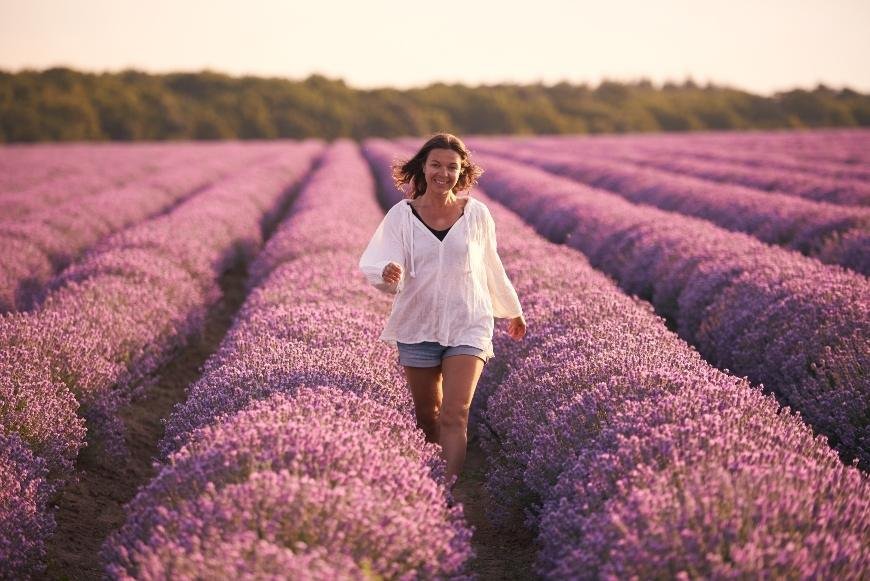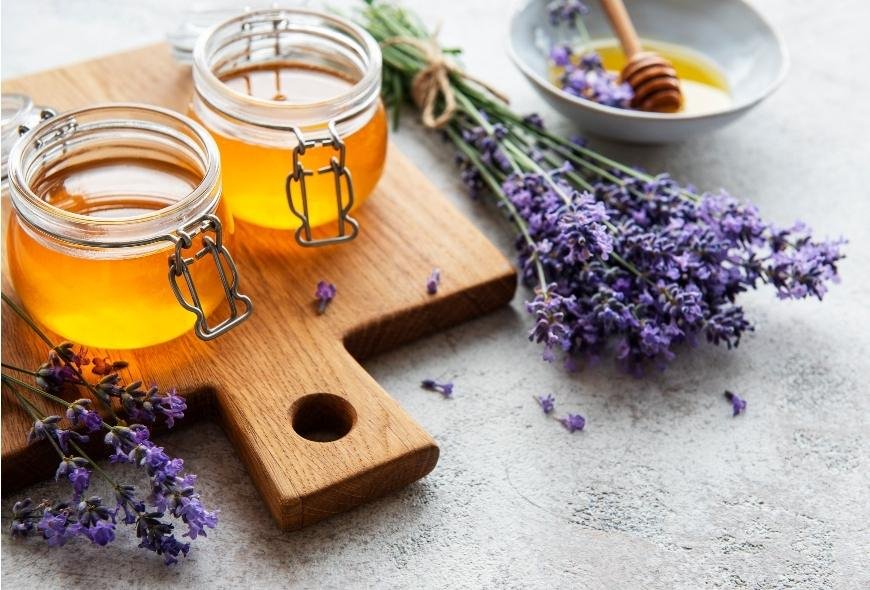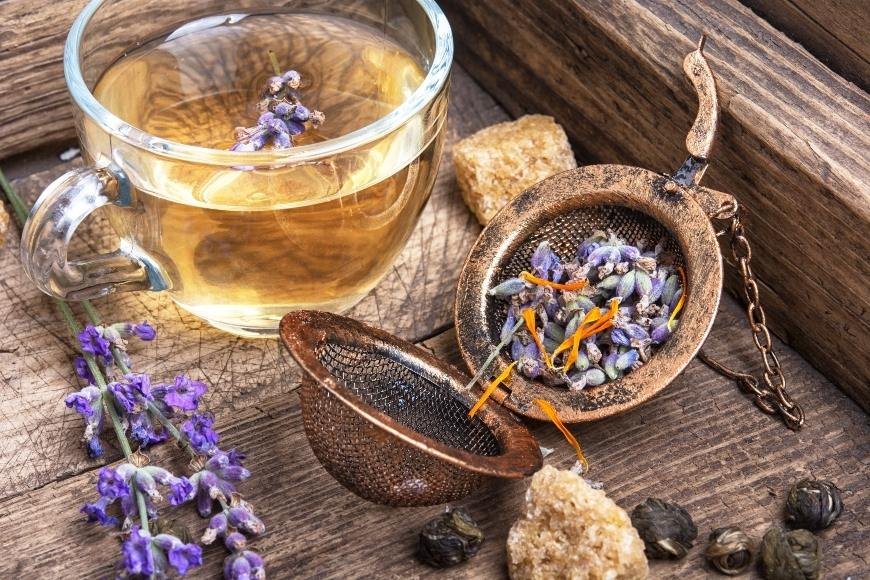How to Use Lavender
Learn how to use lavender for aromatherapy, tea, and creative ideas. Boost your well-being with this versatile plant's many benefits!

Investigating the realm of holistic remedies and relaxation techniques requires one to become acquainted with utilizing lavender. Lavender has been cherished for centuries due to its soothing scent, beautiful appearance, and numerous medicinal properties.
In this comprehensive guide on how to use lavender, we will dive into various methods of harnessing its benefits. You'll discover ways to incorporate lavender essential oil into your daily routine through aromatherapy massage or by applying it directly onto your skin with a carrier oil.
We'll also discuss the art of making tea with lavender and incorporating this versatile plant in culinary creations. Finally, you'll learn about smoking lavender as an alternative method for enjoying its calming effects. By understanding these different uses for lavender, you can enhance your overall well-being while embracing nature's gifts.
Table of Contents:
- Understanding Lavender
- Types of Lavender Plants
- The Many Uses of Lavender
- Identifying Lavender Plants
- Using Lavender Essential Oil
- Making Tea with Lavender
- Cooking with Lavender
- Smoking Lavender
- Frequently Asked Questions How to Use Lavender
- Conclusion
Understanding Lavender
Lavender is a versatile and aromatic plant that has been used for centuries in various ways. From its calming aroma to its multiple therapeutic benefits, lavender has been embraced by many individuals, especially those who embrace natural healing and holistic treatments. In this section, we will investigate the various varieties of lavender plants, their applications and how to distinguish them.
Types of Lavender Plants
There are several species of lavender plants, but the most common ones include:
- Lavandula angustifolia (English Lavender): This is the most popular type due to its sweet fragrance and beautiful purple flowers. It's often used for culinary purposes as well as aromatherapy.
- Lavandula x intermedia (Lavandin): A hybrid between English lavender and spike lavender, lavandin produces more oil than other varieties making it ideal for commercial use in perfumes or soaps.
- Lavandula stoechas (Spanish/French Lavender): Known for its unique flower head with "rabbit ear" petals on top; Spanish/French lavender is commonly used in landscaping but also holds some medicinal properties.
The Many Uses of Lavender

Beyond just being a beautiful addition to your garden or home decor, there are countless ways you can utilize this fragrant herb:
- Aromatherapy: The soothing scent of lavender helps reduce stress levels by promoting relaxation through inhalation or diffusion using an essential oil diffuser.
- Medicinal purposes: Lavender has been used for centuries to treat various ailments such as insomnia, anxiety, and even minor burns. You can use lavender essential oil or make a tea with the flowers and leaves.
- Culinary uses: The fragrant flavor of lavender adds a unique touch to dishes like cookies, cakes, and even savory meals. It's important to note that only certain varieties are suitable for consumption - specifically English Lavender (Lavandula angustifolia).
Identifying Lavender Plants
To ensure you're using the correct type of lavender plant for your needs, it's crucial to be able to identify them accurately:
- Flower shape: Observe the flower head structure; English lavender has compact spikes while Spanish/French varieties have distinct "rabbit ear" petals on top.
- Scent: Crush some leaves between your fingers and take in their aroma; different species will have varying levels of sweetness or camphor-like scents.
- Foliage color:While most lavenders have greenish-gray foliage, some may lean more towards silver or gray tones depending on the variety. li > ul >
In conclusion , understanding how to identify different types of lavender plants is essential when exploring their many uses. Whether you want an aromatic addition to your garden or plan on incorporating this versatile herb into cooking recipes or natural remedies - knowing which variety suits your needs best is key.
Comprehending Lavender is a crucial element of any broadened knowledge on psychedelics, since it can be utilized to facilitate tranquility and slumber. As such, exploring its uses in more detail is important for those looking to benefit from this powerful plant. Moving forward, we will look at how lavender essential oil can be utilized in various ways.
Using Lavender Essential Oil
Lavender essential oil is a popular choice among young adults for its versatile uses and numerous benefits. Extracted from the flowers of the lavender plant, this aromatic oil offers a wide range of applications, from aromatherapy to skincare.
Benefits of Lavender Essential Oil
- Anxiety relief: The calming scent of lavender has been known to help reduce anxiety and stress levels. A few drops in an aromatherapy diffuser can create a relaxing atmosphere at home or work.
- Sleep aid: Adding some lavender essential oil to your bedtime routine may improve sleep quality by promoting relaxation. Try placing a couple of drops on your pillowcase or using it in an evening bath.
- Skin care: Lavender's anti-inflammatory properties make it suitable for soothing irritated skin conditions like acne or eczema. Mix with carrier oils such as coconut or jojoba before applying topically.
- Pain relief: Some studies suggest that massaging diluted lavender essential oil onto sore muscles can help alleviate pain and inflammation caused by physical activity.
Potential Side Effects & Safety Precautions
Lavender essential oil is generally considered safe when used correctly; however, there are potential side effects you should be aware of:
- Allergic reactions: If you have sensitive skin, test the diluted mixture on a small patch before applying it more broadly to avoid irritation or allergic reactions.
- Photosensitivity: Some individuals may experience increased sensitivity to sunlight after using lavender essential oil on their skin. To minimize this risk, avoid direct sun exposure for a few hours following application.
- Pregnancy and breastfeeding: It is best to consult with a healthcare professional before using any essential oils during pregnancy or while breastfeeding.
Understanding Essential Oils
Essential oils are concentrated plant extracts that capture the essence of the plant's scent and flavor. Extracting essential oils can be done through various techniques, such as steam distillation or cold pressing. These potent liquids should always be used sparingly and diluted in carrier oils when applied topically to prevent irritation.
Adding lavender essential oil to your life can be advantageous for both mental and physical health. Remember to use it responsibly by diluting it properly, testing for allergies, and seeking advice from professionals if you have concerns about its usage.
Lavender essential oil may be a great tool for managing stress and anxiety, as well as providing other potential advantages. Let's investigate the potential of brewing tea with lavender to access even more health advantages.
Making Tea with Lavender

Lavender tea is a popular and soothing beverage that can help you unwind after a long day or even provide some relief from anxiety and stress. In this section, we will explore the process of making lavender tea using fresh or dried flowers and leaves.
A. Choosing Fresh or Dried Lavender
Firstly, decide whether you want to use fresh or dried lavender for your tea. Both options have their benefits: fresh lavender offers a more vibrant flavor, while dried lavender has a longer shelf life and can be stored easily in an airtight container. Once the flowers on your lavender plant are close to blossoming, pluck them for optimal flavour.
B. Preparing Your Ingredients
- Fresh Lavender: Rinse the freshly picked flowers under cold water to remove any dirt or insects. Gently pat them dry with paper towels.
- Dried Lavender: Measure out about one tablespoon of dried flowers per cup of boiling water (adjust according to taste).
C. Brewing Your Tea
To brew your delicious cup of calming lavender tea, follow these simple steps:
- In a teapot or heat-resistant glass pitcher, place either the prepared fresh/dried lavenders along with any other herbs like chamomile if desired.
- Pour boiling water over the ingredients until they are completely submerged - approximately one cup per tablespoon of dried flowers used.
- Allow the tea to steep for a period of time determined by your preference.
- Once the tea has reached your desired strength, strain it into a cup or mug using a fine mesh strainer or cheesecloth. Discard the used flowers and leaves.
If you want to add some sweetness to your lavender tea, consider adding honey, sugar, or even stevia as per your liking. You can also enhance its flavor by adding lemon juice for an extra zesty touch.
D. Enjoying Your Lavender Tea Safely
Lavender tea is generally safe for consumption; however, moderation is key. Drinking too much lavender tea may lead to side effects such as drowsiness and digestive issues like nausea or vomiting in some individuals. Pregnant women should, however, be mindful of their intake and seek medical advice before consuming large amounts of lavender tea.
Now that you know how easy it is to make a soothing cup of lavender tea at home go ahead and enjoy this fragrant beverage while reaping its numerous benefits.
Cooking with Lavender
Lavender is not only a beautiful and fragrant plant but also an incredible culinary ingredient that can add a unique flavor to your dishes. Cooking with lavender flowers and leaves, whether fresh or dried, can elevate the taste of various recipes ranging from savory dishes to sweet desserts.
A. Choosing the Right Type of Lavender for Cooking
For cooking purposes, it is essential to select Lavandula angustifolia as its aroma and flavor are more delicate compared to other lavender varieties. The most popular variety used in cooking is Lavandula angustifolia, commonly known as English lavender or culinary lavender due to its sweeter fragrance and milder flavor profile.
B. Preparing Lavender for Culinary Use
- If using fresh lavender, make sure you rinse it thoroughly under cold water before use.
- Gently pat dry the rinsed flowers and leaves using paper towels or clean kitchen cloth.
- Remove flower buds from stems by gently pinching them off; discard any brown or wilted ones.
- Ensure that dried lavender has been kept in an air-tight receptacle, far from any direct sunlight and sources of heat.
C. Recipes Incorporating Lavender
Honey-Lemon Roasted Chicken with Lavender:
This delicious dish combines the flavors of honey, lemon, garlic, rosemary, thyme along with aromatic hints of fresh (or dried) lavender flowers.
To prepare this recipe:
- Preheat your oven to 375°F (190°C).
- Combine honey, lemon juice, garlic, rosemary and thyme leaves as well as crushed lavender flowers in a bowl.
- Season the chicken with salt and pepper before rubbing it generously with the prepared mixture.
- Chop onions and lemons into pieces; put them in a baking pan with sprigs of herbs, like rosemary or thyme. Place the seasoned chicken on top of this bed of vegetables.
- Cover the pan loosely with aluminum foil and roast for about an hour. Remove foil during last half-hour to allow skin to crisp up nicely.
ii) Lavender Shortbread Cookies:
Lavender shortbread cookies are perfect for those who love subtle floral flavors in their desserts.
To make these delightful treats:
- Create a simple shortbread dough by mixing butter, sugar, flour, cornstarch,and finely ground culinary lavender. Chill dough for at least one hour before rolling out onto parchment paper or lightly floured surface;cut into desired shapes using cookie cutters. Bake cookies at preheated oven set at around 325°F (160°C) until edges turn golden brown.
Adding a hint of lavender to your dishes can lend them both flavor and fragrance. Now, let's explore the possibilities of smoking lavender for its calming effects and aromatic qualities.
Smoking Lavender
If you're looking for a unique and natural way to unwind, smoking lavender might be an option worth considering. In this part, we'll discuss the steps for smoking lavender, its effects and potential risks, as well as some safety measures to be aware of.
Can Lavender Be Smoked?
Yes, both fresh and dried lavender flowers can be smoked. The plant is known for its calming properties which may help alleviate stress and anxiety when smoked. However, it's essential to note that not everyone will experience the same effects or benefits from smoking lavender.
How to Smoke Lavender
- Select high-quality lavender: Choose organic or pesticide-free lavender flowers for a cleaner smoke. Make sure they are free from mold or other contaminants.
- Dry the flowers: If using fresh flowers, allow them to dry completely before smoking. This can take anywhere from several days up to two weeks depending on your environment.
- Crumble the dried flowers: Break apart the dried flower buds into smaller pieces suitable for rolling into a joint or packing into a pipe.
- Rolling with tobacco or herbal blend: To make a smoother smoke, mix crushed lavenders with tobacco leaves if you prefer nicotine content otherwise use non-tobacco herbal blends like damiana leaves.
- Use proper equipment :You can smoke lavender using a pipe , a vaporizer or by rolling it into a joint . Choose the method that best suits your preferences and experience level .
Effects of Smoking Lavender
When smoked , lavender is believed to produce calming effects similar to those experienced when using natural relaxants. Smoking lavender is purported to bring about a sense of relaxation, improved mood and diminished stress and anxiety. However, individual experiences will vary.
Frequently Asked Questions How to Use Lavender
How is lavender used?
Lavender is commonly used in various forms such as essential oils, dried flowers, and teas. It's popular for its calming properties and pleasant scent. People use it for aromatherapy, relaxation, skincare, cooking, and even smoking.
What is the best way to consume lavender?
The best way to consume lavender depends on your personal preference and desired effects. For relaxation or sleep aid purposes, using lavender essential oil in a diffuser or applying it topically can be effective. Drinking lavender tea may also provide calming benefits.
How is lavender used by humans?
Lavender has been utilized by humans for centuries due to its versatile nature. It's widely employed in aromatherapy, skincare products like creams and lotions, culinary dishes including desserts and beverages (such as tea), herbal remedies for stress relief or insomnia treatment, perfumes production industry among others.
What does the smell of lavender do to the body?
The smell of lavender triggers a response from our olfactory system that helps promote relaxation and reduce anxiety levels within the body. Research suggests that inhaling this aroma can decrease heart rate variability which leads towards an overall sense of calmness making it beneficial during times when experiencing stress-related issues like insomnia (source).
Conclusion
Using lavender in all its forms can be an incredibly rewarding experience. Whether you use it as essential oil, make tea with it, cook with it or even smoke the flowers themselves - there are many ways to enjoy this beautiful plant and benefit from its therapeutic effects. Having a good comprehension of the right way to use lavender can let us benefit from its long-standing medicinal effects.






































































































































